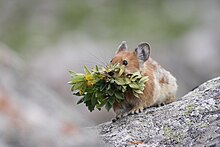Turkestan red pika
| Turkestan red pika | |
|---|---|

| |
| Scientific classification | |
| Domain: | Eukaryota |
| Kingdom: | Animalia |
| Phylum: | Chordata |
| Class: | Mammalia |
| Order: | Lagomorpha |
| Family: | Ochotonidae |
| Genus: | Ochotona |
| Species: | O. rutila
|
| Binomial name | |
| Ochotona rutila (
Severtzov , 1873) | |

| |
| Turkestan red pika range | |
The Turkestani red pika (Ochotona rutila) is a species of
Taxonomy
The Turkestan red pika is one of the 30 recognized species of
Description
The Turkestan red pika measures 19.6 to 23 cm (7.7 to 9.1 in) in length, of which 9.5 to 11 cm (3.7 to 4.3 in) is the tail. It weighs 220 to 320 g (7.8 to 11.3 oz).
In contrast with most other pikas, the Turkestan red pika is a quiet species, and is also commonly known as the "silent" pika. It has no alarm calls and no song vocalizations. In alarm conditions, it takes cover under rocks and emits a chattering call which is similar to that of the northern pika (
Distribution and habitat
The region of
It is a rock-dwelling pika which usually inhabits
Behavior and ecology
The Turkestan red pika is a
The female has a low fertility rate, and generally produces two litters each year, with two to six (averaging 4.2) young, during the breeding season from spring to summer.[4] The offspring are not reproductively active in their birth summer.[5] Throughout much of the summer after their birth, the young live with their parents and forage on vegetation stored by them. During the following winter most juveniles live with their parents. The adult male and the female are rarely seen together during autumn, even though they have a mutual home range.[4]
The stoat (
Status and conservation
Since 1996, the Turkestan red pika is rated as a species of
Notes
- Ochotona roylei).[2]
References
- ^ . Retrieved 14 November 2021.
- ^ ISBN 978-354-072446-9.
- ^ OCLC 62265494.
- ^ ISBN 978-283-170019-9.
- ^ ISBN 978-140-083411-2.
- ^ "Turkestan | Definition of Turkestan in English by Oxford Dictionaries". Oxford Dictionaries | English. 2017. Archived from the original on 26 October 2017. Retrieved 28 October 2017.
External links
- Photographs of Turkestan red pika – Animal.Photos

